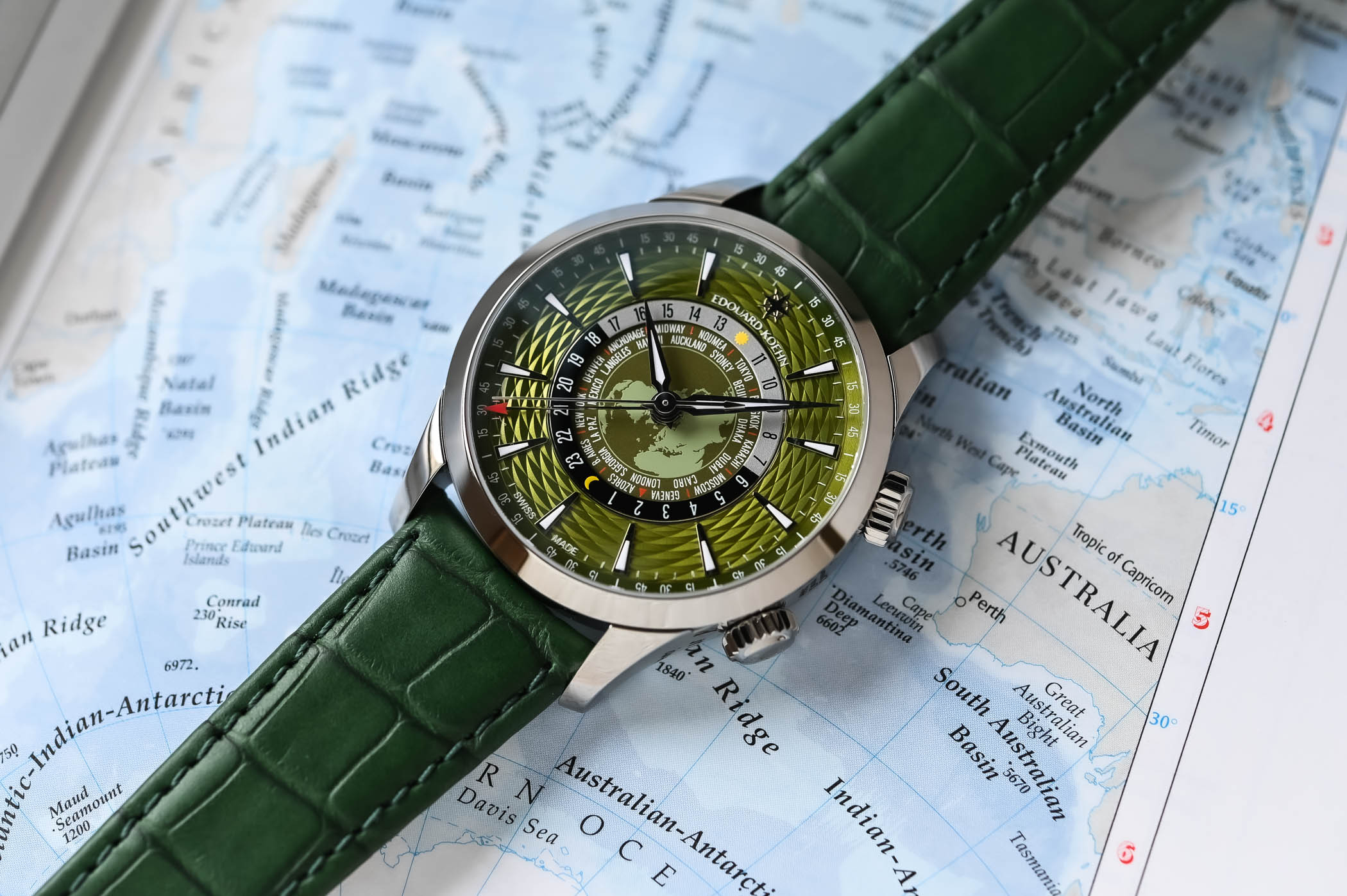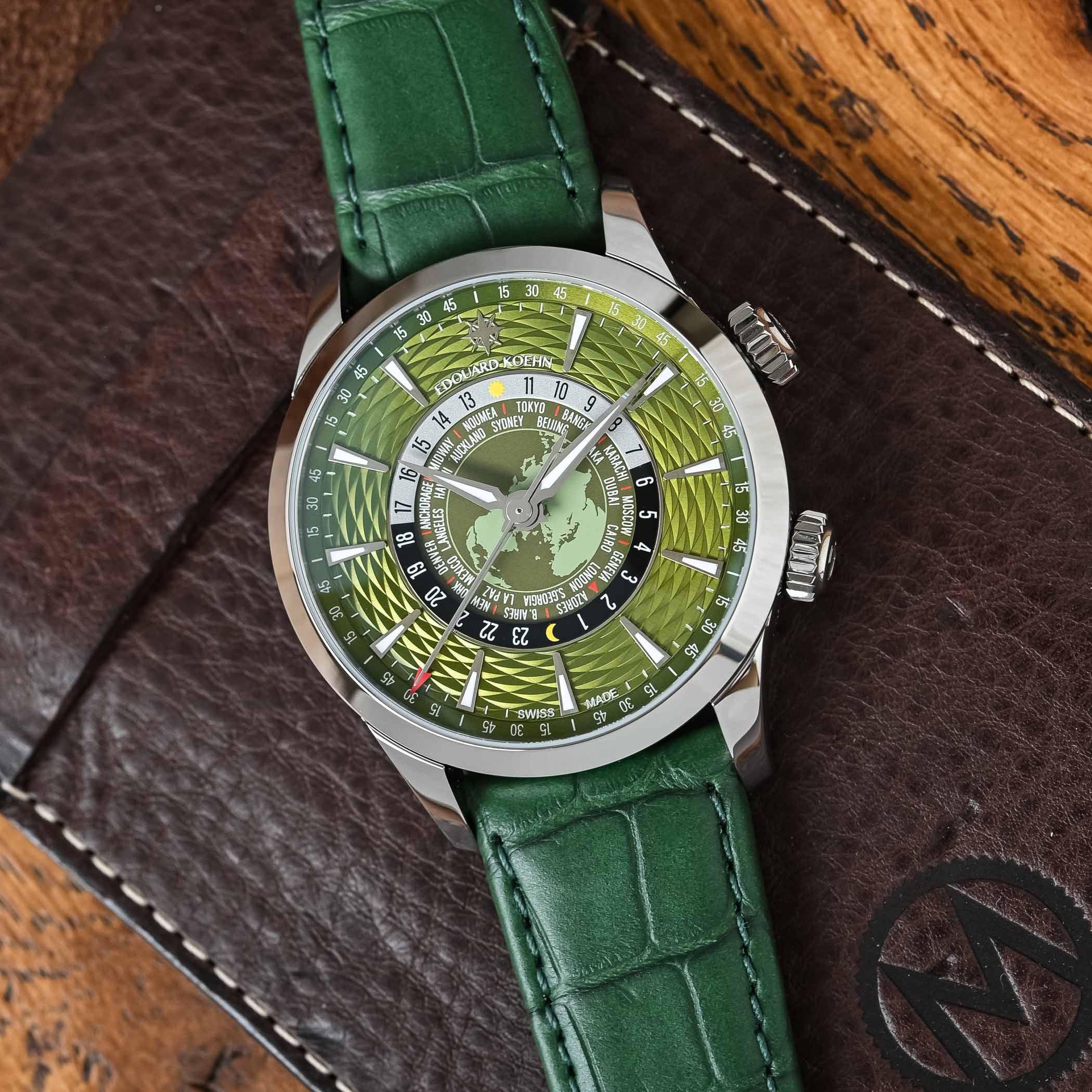The Edouard Koehn World Heritage II, a Rare Combination of Worldtime and Alarm Functions
Tracking time around the world and never missing an early morning flight is possible with this rather compelling series.

Operating out of La Chaux-de-Fonds, Switzerland, for several years now, the brand Edouard Koehn carries four distinct collections. Of particular interest is the model introduced in 2021 as part of the World Heritage line, blending two practical complications: world time and alarm functions. While several mechanical watches offer combinations of an alarm with a GMT or dual time display, the fusion of alarm and world time is a rarity in the horological world. In 2023, Edouard Koehn introduced a limited edition World Heritage II series, maintaining the same concept and underlying movement while offering a fresh presentation for enthusiasts to explore; we had a hands-on experience, and here are our impressions.
First, a few words about the name. Edouard Koehn (1839-1908) was a watchmaker and at one time the co-owner of Patek, Philippe & Cie (a specialist of world time watches…) A name with roots tracing back to the 19th century, it resurfaced in the modern watchmaking scene in 2020 thanks to Bernard F. Fleury, a seasoned veteran in the industry known for his work as the CEO of Vulcain in the early 2000s (a specialist of alarm watches…), where he played a significant role in reviving the brand’s reputation within the industry. Bernard Fleury discovered a watch bearing Edouard Koehn’s name at an auction; further research led to interesting discoveries, exciting enough to convince Fleury of the name’s potential and rights purchased in 2015. Edouard Koehn produces two collections: a contemporary chronograph called Tempus and the World Heritage watches with universal time and alarm functions.
The Edouard Koehn World Heritage II series we look at today comprises five references, primarily distinguished by the colour of the dial. The model is housed in a 42mm diameter case with a classic and elegant design, however, crafted from grade 5 titanium and measures 14.5mm in height. It features sapphire crystal on both sides and has a water resistance guarantee of up to 50 meters.
The bezel, showcasing a notable thickness, gleams with a polished finish, harmonizing with the rest of the surfaces. The curved lugs seamlessly integrate with the middle case, while the caseback is securely fastened by six screws. The crown positioned at 2 o’clock is adorned with the brand’s wind rose symbol and serves the purposes of winding, time setting and adjusting the world disc. At 4 o’clock, the crown, marked with a bell symbol, is dedicated to setting and winding the alarm. Both crowns feature fluting for easy handling. Despite its substantial size, the watch is weightless, thanks to the use of durable yet lightweight titanium, ensuring a comfortable wearing experience – something that could be a bit puzzling at first, as the watch is substantially lighter than its size would let you imagine. Using titanium contributes to optimal acoustics for the alarm function, highlighting the consideration given to both form and function.
While the case design exudes simplicity, the dial of the World Heritage II series unveils a captivating intricacy. Offered in a palette of ice blue, silver, green, blue, and anthracite, each dial is built around a central disc featuring a raised image of the world’s northern hemisphere. This central disc is encircled by a ring that displays locations representing various time zones. Notably, London is highlighted by a red triangle, denoting its important GMT zone, while Paris gives way to Geneva, perhaps a nod to the city’s heightened significance for the watchmaker.
Adjacent to the central disc with the map and time zone locations ring, which completes a full rotation in 24 hours, is a 24-hour fixed ring. The light grey section represents day hours (7 to 17), while the black portion signifies night hours (18 to 6). Notably, the 12 o’clock position is marked with a sun image, symbolizing noon, while the 24 o’clock position features a crescent, signifying midnight. Another essential element is the coloured guilloche ring, housing the outer minutes track and applied hour indices. Faceted and polished indices are filled with Super-LumiNova for enhanced visibility in low-light conditions. The 12 o’clock index is replaced by a proud display of the brand’s metallic wind rose logo, which is also applied, though it doesn’t illuminate in the dark.
The central alpha-type hour and minutes hands with Super-LumiNova are adjusted with the dedicated crown in position 3; the stop-second function is a plus as it allows for precise time setting. In position 2, this crown quickly adjusts the world time disc. Naturally, your time zone needs to be aligned with your current hour on the 24-hour ring; then, you will get a proper reading of hours in other locations worldwide.
Finally, the World Heritage II outermost ring is graduated for 15-minute intervals per hour, serving the purpose of setting the alarm. To activate the alarm function, the crown at 4 o’clock needs to be pulled to position 2. The central hand, adorned with a red arrowhead, can then be rotated counterclockwise to set the desired alarm time. Additionally, winding the designated alarm barrel is accomplished with the crown in position 1. Activating the alarm requires pulling the crown to position 2 – an effective enough solution for using the watch as a wake-up call, even if it’s not the most practical one when the watch is worn – push the crown back by accident, and you are in trouble.
Through the transparent sapphire crystal caseback, the automatic EK-MVTWTA01 calibre reveals meticulous finishes, including perlage, Geneva stripes adorning the ball-bearing-mounted central oscillating mass, sunburst finish on the wheels and blued screws.
Developed in collaboration with Concepto, an independent manufacturer renowned for crafting high-end mechanical movements in La Chaux-de-Fonds, this calibre is derived from the A. Schild AS5008 base and offers a range of intriguing solutions. It features a double-double barrel which simultaneously winds the watch and the alarm functions – a typical configuration. However, what sets it apart is the central automatic rotor’s ability to wind both barrels, each in its respective direction. The EK-MVTWTA01 calibre boasts a 48-hour power reserve and operates at a frequency of 28,800 vibrations/hour.
To complete the ensemble, Edouard Koehn pairs the World Heritage II watches with an alligator leather strap (22mm), available in various colour options to complement each dial variant, secured to the wrist by a deployment buckle featuring security push buttons. Limited to 88 watches per colour variant, Edouard Koehn’s World Heritage II is reasonably priced at CHF 8,500 – which feels quite fair for such a complex watch with an intricate dial and a titanium case.
For more, please visit www.edouardkoehn.com.


















2 responses
In the first image at the top is the alarm set at 0730, 1930 or most improbably 2130? In other words how does the alarm know it is AM or PM?
Hi Denis, thanks for your comprehensive article. A beautiful watch indeed, for a very reasonable price. Owning a Vulcain Cricket from early 2000 I am glad to see that Mr. Fleury didn’t lose passion for alarm watches (if I recall well, at that time Vulcain offered a worldtimer-alarm as well).
Alarm is one of the more useful complications in real life to me (more useful than a chrono to check your eggs cooking time LOL) the downside is that it is difficult to set it to the exact minute (and as Yachtmaster correctly addressed, you can set it only on a 12 hours basis).
Best regards,
Andrea